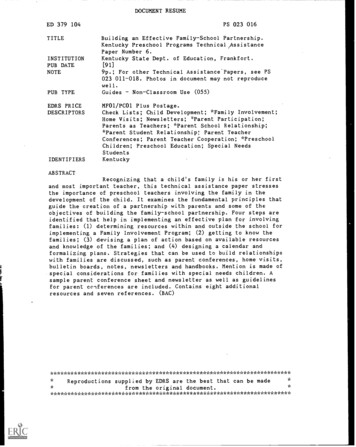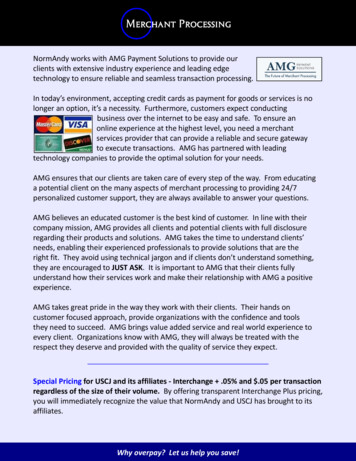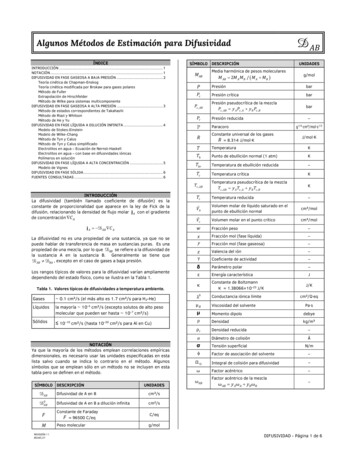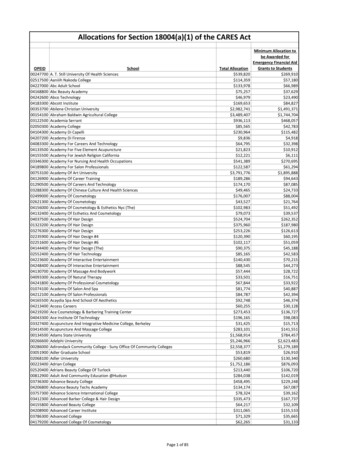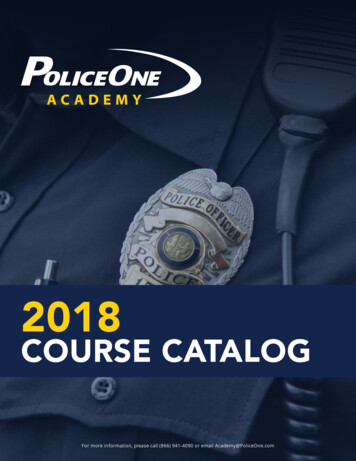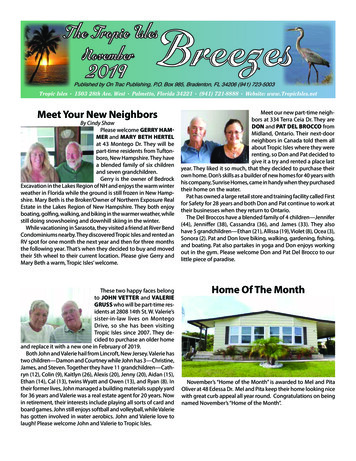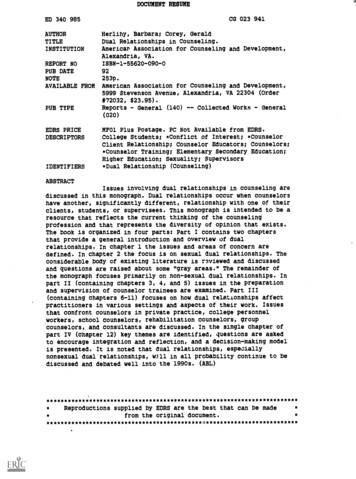
Transcription
DOCUMENT RESUMECG 023 941ED 340 985AUTHORTITLEINSTITUTIONREPORT NOPUB DATENOTEAVAILABLE FROMPUB TYPEHerlihy, Barbara; Corey, GeraldDual Relationships in Counseling.American Association for Counseling and Development,Alexandria, VA.ISBN-1-55620-090-092253p.American Association for Counseling and Development,5999 Stevenson Avenue, Alexandria, VA 22304 (Order#72032, 23.95).Reports - General (140) -- Collected Works - General(020)EDRS PRICEDESCRIPTORSIDENTIFIERSMF01 Plus Postage. PC Not Available from EDRS.College Students; *Conflict of Interest; *CounselorClient Relationship; Counselor Educators; Counselors;*Counselor Training; Elementary Secondary Education;Higher Education; Sexuality; Supervisors*Dual Relationship (Counseling)ABSTRACTIssues involving dual relationships in counseling arediscussed in this monograph. Dual relationships occur when counselorshave another, significantly different, relationship with one of theirclients, students, or supervisees. This monograph is intended to be aresource that reflects the current thinking of the counselingprofession and that represents the diversity of opinion that exists.The book is organized in four parts: Part I contains two chaptersthat provide a general introduction and overview of dualrelationships. In chapter 1 the issues and areas of concern aredefined. In chapter 2 the focus is on sexual dual relationships. Theconsiderable body of existing literature is reviewed and discussedand questions are raised about some "gray areas." The remainder ofthe monograph focuses primarily on non-sexual dual relationships. Inpart II (containing chapters 3, 4, and 5) issues in the preparationand supervision of counselor trainees are examined. Part III(containing chapters 6-11) focuses on how dual relationships affectpractitioners in various settings and aspects of their work. Issuesthat confront counselors in private practice, college personnelyorkers, school counselors, rehabilitation counselors, groupcounselors, and consultants are discussed. In the single chapter ofpart IV (chapter 12) key themes are identified, questions are askedto encourage integration and reflection, and a decision-making modelis presented. It is noted that dual relationships, especiallynonsexual dual relationships, will in all probability continue to bediscussed and debated well into the 19905. **************************Reproductions supplied by EDRS are the best that can be madefrom the original ******************************
ralU.S. DEPARTMENT OF EDUCATIONand ImprovementOffice ol Eaucellootl ResearchINFORMATIONEDUCATIONAL RESOURCESCENTER IEDIC)isproduced a&fal.this document nal been or organizationreceived from the personOriginating itbeen made to improveO Minor changes havereproduction oualityMateo in this docuPOinti of view or opinions represent officialmem do not necessarilyOE RI POsition or policy"PERMISSION TO REPRODUCE THISMATERIAL IN MICROFICHE ONLYHAS BEEN GRANTED BYe2/4/ ,201/TO THE EDUCATIONAL RESOURCESINFO4MATION CENTER (ERIC)"PY AVAILABLE
DUAL RELATIONSHIPSIN COUNSELINGBARBARA HERLIHY, PhDUniversity of Houston-Clear LakeandGERALD COREY, EdDCalifornia State University, FullertonAssociation forACIA- American%.ounseling and Development5999 Slevenon Ave. Alexandria, VA 223043
Copyright 1992 by the American Association for Counselingand DevelopmentAll rights reserved.American Association for Counseling am, Development5999 Stevenson AvenueAlexandria, VA 22304Cover design by Sarah Jane ValdezLibrary of Congress Cataloging-in-Publication DataHerlihy, Barbara.Dual relationships in counseling / Barbara Herlihy and Gerald Corey.p. cm.Includes bibliographical references.ISBN 1-55620-090-01. Counselor and client. 2. CounselorsProfessional ethics.I. Corey, Gerald. II. Title.BF637.C6H425 1992158'.3dc2091-32929CIPPrinted in the United States of America
To our colleagues who wrestle withthe issues explored in this book5
CONTENTSABOUT THE AUTHORSGUEST CONTRIBUTORSACKNOWLEDGEMENTSPREFACEPART I:INTRODUCTIONChapter 1:Chapter 2:PART II:Dual Relationships in PerspectiveSexual Dual Relationships319ISSUES IN COUNSELOR PREPARATIONChapter 3:Chapter 4:Chapter 5:Counselor EducationPreparation of Group CounselorsSupervision4583109PART III: ISSUES IN COUNSELING PRACTICEChapter 6:Chapter 7:Chapter 8:Chapter 9:Chapter 10:Chapter 11:Private PracticeCollege Personnel WorkSchool Counseling .Rehabilitation CounselingGroup CounselingConsultation129155171183197211PART IV: CONCLUDING COMMENTSChapter 12: Key Themes. Questions, andDecision MakingREFERENCES AND SUGGESTED READINGSt;223235
ABOUT THE AUTHORSBarbara Herlihy is associate professor of counselor education at the University of Houston-ClearLake. She also maintains a limited private practicein counseling. She received her doctorate in counseling psychology from Northwestern Universityand has completed 2 years of postgraduate training in Gestalt therapy. She is a Licensed Professional Counselor in Texas and a National CertifiedCounselor. She is co-chair (with Madelyn Healy)of the ACES Ethics Interest Network and servedon the AACD Special Task Force on Impaired Counselors. She hasserved as chair of the MCD Ethics Committee (1987-1989) and asa member of the Professional Standards and Ethics Committee ofthe Association for Specialists in Group Work. She received (with1,arry Golden) the 1990 Professional Writing Award of the TexasAssociation for Counseling and Development.Dr. Herlihy has authored or (oauthored numerous articles onethical and legal issues in counseling. Much of her writing hasfocused on confidentiality and privileged communication in thehelping professions. Her recent book, with coauthor Larry Golden,is the fourth edition of the MCI) Ethical Standards Casebook(1990).Dr. Herlihy regularly teaches courses in professional ethics andgroup counseling, and she supervises counselor interns. She consults with school districts, profes:iional groups, and a victim/offender restitution program. In her leisure time she likes to travel.play racquetball, or curl up with a good novel.7
Gerald Corey holds a joint appointment as prolessor of human services and counseling at California State University, Fullerton, and served asthe coordinator of the Human Services Programfrom 1983 to 1991. He is a licensed counselingpsychologist, and he received his doctorate incounseling from the University of Southern California. lie is a diplomate in counseling psycholoay,Anwrican Board of Professional Psycho loay: is aNational Certified Counselor: and is registered asa National Health Service Provider in Psycholoay. Ile is a fellow ofthe American Psychological Association (Counseling Psycholoay)and of the Association for Specialists in Group Work. Ile has servedas a menther of the Professional Standards and Ethics Committeeof the Association for Specialists in Group Work. Ile was given theOutstanding Professor Award for 1991 by California State University, Fullerton.Dr. Corey has authored or coauthored mmwrous articles and has10 books in print in the field of counseling. Among these books areTheory and Practice of Counseling and Psychotlwrapy (4th ed.1991). Theory and Practice of Group Counseling (3rd ed. 1990). and.with Marianne Corey and Patrick Callanan, Issues and Ethics in theI lelping Professions (3rd ed. 1988).Dr. Corey has a special interest in teaching courses in ethical andprofessional issues, group coup. -ling. and theories and techniquesof counseling. In hisleisure time, he likes to travel, hike in themountains, and bicycle ride.
GUEST CONTRIBUTORSOur guest contributors have enriched this book immensely. Bysharing their thoughts and opinions. they have provided a diversityofviewpoints and have raised issues that are well worth considering.Following is a list of these individuals, their institutional affiliations.and the chapters in which their contributions appear:L. DiAnne Borderi, associate professor of counselor education.University of North Carolina at Greensboro (chapter 5. Supervision)A. Michael Dougherty, professor and head. Department of Human Services. Western Carolina University. Cullowhee. North Car-olina: and former elementary and junior high school counselor(chapter 8. School Counseling, and chapter 11. Consultation)Holly Forester-Miller, associate professor of counseling. University of West Virginia College of Graduate Studies (chapter 4. Preparation of Group Counselors)George M. Garda, research professor. associate dean for research, and acting head for the Division of Counseling. EducationalPsychology, and Instructional Technology. University of Georgia:and clinical professor. Department of Psychiatry. Medical Collegeof Georgia (chapter 4. Preparation of Group Counselors, and chapter 10. Group Counseling)Larry Golden, associate professor of counseling. University ofTexas at San Antonio (chapter 6. Private Practice)Karen Strohm Kitchener, professor and training director. Counseling Psychology Division. University of Denver (chapter 6. PrivatePractice)Arthur P. Lloyd, professor of counselor education. Idaho StateUniversity. Pocatello (chapter 3. Counselor Education)Susan L. Naas, graduate student in counseling. University ofHouston-Clear Lake (chapter 3. Counselor Education)t,1
DUAL REMTIONSIIIPS IN COUNSELINGSue Spooner, associate professor of college student personneladministration. University of Northern Colorado, Greeley (chapter7, College Personnel Work)Holly A. Stadler, professor of education and medicine. Universityof Missouri-Kansas City (chapter 3, Counselor Education)Rex Stockton, professor of counseling and educational psychology, Indiana University (chapter 5, Supervision)George T. Williams, associate professor of counseling, CaliforniaState University, Fullerton (chapter 4, Preparation of Group Counselors)Mary Ellen Young, assistant professor of physical nwdicine andrehabilitation, Baylor College of Medicine: and adjunct professor.University of Houston-Clear Lake (chapter 9, Rehabilitation Counselingj10
ACKNOWLEDGEMENTSWe thank the following reviewers, who carefully read the maimscript and offered valuable suggestions for improvement: DebraBorys of the California School of Professional Psycholoq. JeffreyKottler of The Citadel. Sharon E. Robinson of Arizona State University. and Jim Witgil of Ohio State University. We want to acknowledge others who read parts of the manuscript and gave us helpfulfeedback: Marianne Schneider Corey. consultant. ldyllwild. California: Jorja Manos Prover. University of Southern California: PatrickCallanan, private practice. Santa Ana, California: George Williams,California State University. Fullerton: and Amy Manfrini. CaliforniaState University. Fullerton.Student reviewers were Susan L. Naas. who assisted with research and reacted to the chapters in their early stages. and LynnHenning and Glennda Gihnour. two graduate assistants from California State University, Fullerton.Marlene Lewis assisted with word processing and resolved countless technical questions.Finally, we want to express our appreciation to the AACD stallmembers who worked closely with us throughout this endeavor. Inparticular. Elaine Pirrone. acquisitions atilt developnwnt editor, hasbeen an enthusiastic source of support and assistance. The careftilwork of Lucy Blanton. copyeditor. greatly improved the book's clarity and format.
1 PREFACEAs helping professionals. we enter into a dual relationship whenever we have another, significantly different relationship with oneof our clients. students, or supervisees. When we play dual roles.the potential exists for a conflict of interest and for exploiting thosewho seek our help. Our profession has become increasingly concerned about dual relationships as an ethical issue. Throughoutthe 1980s. sexual dual relationships received a great deal of atten-iion in both the professional literature and the popular press.Today. there is clear agreement that sexual dual relationships areunethical, and prohibitions against them have been codified intoethical standards and law.Lately, nonsexual dual relationships have been getting more attention. Articles on the topic have been appearing more frequentlyin our professional journals. Recent revisions of the ethical standards of some professional associations have dealt more extensivelywith dual relationship issues. There has also been an increase inlegislative and governing board activity. For example, in Californiathe Board of Behavioral Science Examiners and the Board of Psychology are developing regulatory language that attempts to addresseffectively the issue of nonsexual dual relationships in psychotherapy. The enforcement programs of both boards are faced with manyconsumer complaints and disciplinary cases that involve harm toclients as a result of a variety of dual relationships.Nonsexual dual relationships can be complex. The issues are pervasive and affect counselors and human development specialists inall work settings and in relationships with individual clients, students, or supervisees; in relationships with families: in relationshipswith groups: and in supervision or consultatioa activities. Just afew examples of problematic or potentially problematic situationsare bartering with a client for goods or services, counseling a friend.
xivDUAL RELATIONSHIPS "V COUNSELINGproviding therapy to a student or supervisee, conducting experiential groups as part of a group counseling class, becoming involvedin a discipline matter with a student client, and managing the casebudget for a client in rehabilitation counseling.When conscientious professionals look for guidance regardingdual relationships, they may find conflicting advice. The AACD Eth7teal Standards (1988) state that "dual relationships with clients thatmight impair the member's objectivity and professional judgmentmust be avoided. ." (emphasis ours). Yet, many writers have asserted that not all dual relationships can he avoided nor are theynecessarily harmful.Considerable disagreement exists around some dual relationshipissues. We (Barbara Herlihy and Gerald Corey) have seen this disagreement in our own recent experiences. During the summer of.1990, Gerald Corey proposed to the faculty in his university'shuman services program that a policy statement be created on thesubject of faculty seeing students as clients. His proposal stirredup quite a bit of controversy and evolved tnto a lengthy, two-partposition paper reflecting a diversity of viewpoints. At much the sametime, Barbara Herlihy was asked to consult with the staff of heruniversity's counseling center to help develop a policy on referringstudents to counselors in private practice. The first question raisedwas whether it is ever appropriate for college counselors to referclients to themselves when they also have a private practice. Thisgenerated a host of related questions and led to a series of extendeddiscussions. As each of us began to talk with friends and colleaguesaround the country, it became apparent to us that interest in dualrelationships is widespread and that there is a broad spectrum ofopinion surrounding many issues. This impression was reinforcedduring the 1991 AACD Convention in Reno, when the topic of dualrelationships received a great deal of attention and a number ofissues were heatedly debated.We hope that this book will be useful to others who share ourinterest in dual relationships and who struggle, as we do, to find adear personal stance on the issues involved. We intend it to be aresource that reflects the current thinking of our profession On thetopic. We also want it to represent th t. diversity of opinion thatexists. To that end, we have asked several guest contributors topresent their positions on various specific topics.We have organized the book so that part 1 presents generalintroduction and overview of dual relationships. In chapter 1, wedefine the issues and areas of concern. In chapter 2, we focus onsexual dual relationships, reviewing and discussing the consider.3
Prefacexvable body of existing literature and raising questions about some-gray areas." The remainder of the book focuses primarily on nonsexual dual relationships. In part II (chapters 3. 4. and 5). we ex-amine issues in the preparation and supervision of counselortrainees. Part III (chapters 6 through 11) focuses on how dual relationships affect practitioners in various settings and aspects oftheir work. We discuss issues that confrov.: counselors in privatepractice. college personnel workers. school counselors, rehabilitation counselors, group counselors. and consultants. At the end, inpart IV (chapter 12). we identify key themes. ask questions toencourage integration and reflection. and offer a decision-makingmodel. We make no claim to having discovered answers to complexand difficult questions. Rather, it is our aim to raise issues, presenta range of viewpoints on these issues, and discuss our own positions. We hope that you will use this material as a springboard forfurther reflection and discussion. We invite you to think about theissues that are raised. apply them to your own situation. and discuss them with colleagues.This work focuses on a specialized topic in counselor preparationand counseling practice. Because dual relationships are becominga topic of increased discussion, this book can be used as a supplement to any of the textbooks that are used for courses in ethicaland professional issues. We also expect that counselor educatorswill find this book useful for getting a current view of the potentialproblems and promises that are associated with dual relationships.The book can also be used in practicum. fieldwork. and internshipseminars. Finally, we hope the book will be useful to practitionerswho struggle with dual relationship issues in their work.We anticipate that dual relationshipsespecially nonsexual dualrelationshipswill continue to be discussed and debated well intothe 1990s. As with any complex ethical issue. complete agreementmay never be reached nor would it necessarily be desirable. However, as conscientious professionals. we must strive to clarify ourown stance and develop our own guidelines tor practice. within thelimits of ethical codes, current knowledge. and divergent opinions.
PART I:INTRODUCTION
1 CIMPTER 1DUAL RELATIONSHIPSIN PERSPECTIVEDual relationships occur when professionals assume two rolessimultaneously or sequentially with a person seeking help. Thismay mean two professional roles, such as counselor and teacher,or combining a professional and a nonprofessional role, such ascounselor and friend or counselor and lover. Dual relationship issues, both sexual and nonsexual, affect virtually all counselors andhuman development specialists regardless of their work setting orclientele.We assume that you, the reader of this book, havestruggled with some complex and difficult dual relationship issues in your work as a helping professional. Wehope that as you read the book, you will take time toreflect and consider how the material applies to you andyour situation. Questions that may be useful to ask atthe outset include the following:What are some of the dual relationship strugglesyou have faced in the past or are now facing?flow have you dealt, or how are you coping now,with these issues?What information do you hope to find in this bookthat will help you resolve your questions and con.cerns about the issues you cont.ront in your work?Over the past decade, much has been written about the harmthat can be done when helping professionals enter into sexual re-
4DUAL RELATIONSHIPS IN COUNSELINGlationships with their clients. The dangers of sexual dual relationships between counselor and client, supervisor and supervisee. andfaculty member and student have been well documented. Chapter2 will examine sexual dual relationships in detail.In this chapter. we focus on nonsexual dual relationships. Welook at general issues that arise in all settings. These questionsguide our discussion:What guidance do our codes of ethics offer about dualrelationships?What makes dual relationships so problematic forpractitioners?What factors create the potential for harm?What are the risks inherent in dual relationships, for all parties directly or indirectly involved?What are some possible benefits in dual relationships?What safeguards can be built in to minimize risks?ETHICAL STANDARDSMost professional codes of ethics address the issue of dual relationships. as the following excerpts of standards from ethical codesfor counselors, psychologists, and social workers that speak to nonsexual dual relationships illustrate:When the member has other relationships. partksularly of anadministrative, and/or evaluative nature with an individualseeking counseling services, the member must not serve as thecounselor but should refer the individual to another professional. Only in instances where such an alternative is unavailable and where the individual's condition warrants counselingintervention should the member enter into and/or maintain acounseling relationship. Dual relationships with clients thatmight impair the member's objectivity and professional judgment (e.g., as with dose friends or relatives) must be avoidedand/or the counseling relationship terminated through referralto another competent professional. (American Association forCounseling and Development (AACD), 1988)Psychologists are continually cognizant of their own needs andof their potentially influential position vis-A-vis persons suchas clients, students, and subordinates. They avoid exploitingthe trust and dependency of such persons. Psychologists make17
Dual Relationships in Perspective5every effort to avoid dual relationships that could impair theirprofessional judgment or increase the risk of exploitation. Examples of such dual relationships include, but are not limitedto, research with and treatment of employees, students, supervisees. close friends, or relatives. (American Psychological Association IAPAI, 1989)Clinical social workers use care to prevent the intrusion of theirown personal needs into relationships with clients. They recognize that the private and personal nature of the therapeuticrelationship may unrealistically intensify clients' feelings toward them, thus increasing their obligation to maintain professional objectivity. Therefore, specifically:Clinical social workers avoid entering treatment relationshipsin which their professional judgment will be compromised byprior association with or knowledge of a client. Examples mightinclude treatment of one's family members, close friends, associates, employees, or others whose welfare could be jeopardized by such a dual relationship.Clinical social workers do not initiate, and should avoid whenpossible, personal relationships or dual roles with current clients, or with any former clients whose feelings toward themmay still be derived from or influenced by the former profes.sional relationship. (National Federation of Societies for ClinicalSocial Work INFSCSWI, 1985)As we noted in the preface. nonsexual dual relationships are receMng increased attention. One example of this increased scrutinyis a set of proposed draft regulations regarding dual relationshipsthat would impact the work of helping professionals in California.These draft regulations were the subject of a joint hearing of theBoard of Behavioral Science Examiners and the Board of Psychologyheld in December 1990. The proposed draft, which made a comprehensive attempt to address the issues involved in dual relationships, includes these statements:(a) Psychologists, psychological assistants. registered psychologists, and psychological interns shall avoid dual relationshipswhich could impair their professional judgment or increase therisk of exploitation and/or harm to the patient. Involvement insuch dual relationships is prohibited and constitutes unprofessional conduct and grounds for disciplinary action.(b) A dual relationship exists when a psychologist, psychologicalassistant, registered psychologist, or psychological intern has arelationship which is in addition to, or outside of, the primaryrelationship of providing professional psychological services. InS
6DUAL RELATIONSHIPS IN COUNSELINGaddition to personal. social, and business relationships, dual relationships include secondary financial relationships.(c) When a psychologist, psychological assistant, registered psychologist, or psychological intern reasonably should know that adual relationship is developing, the provider shall determinewhether the dual relationship can be prevented and the primaryprofessional relationship protected. At a mininmm, this shall indude consultation by the provider with another psychologist forthe specific purpose of objectively assessing the situation.(d) When the psychologist, psychological assistant, registered psychologist, or psychological intern reasonably should know that aprohibited dual relationship cannot be prevented, appropriatesteps shall be taken to termiliate all relationships to ensure thatthe professional relationship has been adequately resolved to bestprotect the interests of the patient. (Board of Behavioral ScienceExaminers. 1989)As can be seen. these proposed regulations address dual relationships quite extensively. Dual relationships include personal. social,business, and secondary financial relationships. Practitioners areexpected to "reasonably know" that a dual relationship is developingand to consult with a colleague to see whether it can be prevented.If it cannot be prevented then the relationship should be terminated.During the hearing held to discuss these proposed regulations.differing reactions were voiced. One attendee suggested t hat avoidance of all dual relationships should be encouraged. whereas otherswere concerned that written regulations might end up prohibitinginnocent conduct. A middle-ground suggestion was that "insteadof trying to ban every conceivable dual relationship that might causeharm.the boards try to ban specific conduct that is clearly improper and upon which there is consensus" (Leslie, 1991, p. 18).A second example of increased attention to nonsexual dual rela.tionships can be found in the draft of proposed revisions to theAmerican Psychological Association (APA) ('ode of ethics. This draftcontained a section on "potentially harmful dual relationships":(a) Psychologists who have a professional rdationship with il pa-tient. client. student, supervism, reear b subject. or organiza-tion refrain from becoming involved in aimtlwr concurrentpersonal, professional. financial, or other relationship with suchpartv if it k reasonably foreseeable that doing so inight interferewith I heir effectively rendering professional psychological set-viersor might harm or exploit that party.I9
Dual Relationships in Perspective7(b) Likewise, whenever feasible, psychologists refrain from takingon professional obligations in which preexisting relationshipswould create such risks.(c) Minimal or remote relationships are unlikely to violate thisstandard.(d) When a psychologist knows or should know that a potentiallyharmful dual relationship has arisen, the psychologist promptlyattempts to resolve it with due regard for the best interest of theaffected person and with maximum feasible compliance with theEthics Code. ("Draft." 1991)At this time, we do not know whether regulations like those proposed in California and by the APA represent the wave of the future,or whether it will eventually be decided that it is best left to profes-sionals' judgment to distinguish between harmful nonsexual dualrelationships and those that are benign. In the absence of specificguidance, we are left with many areas of uncertainty.Although ethical codes generally prohibit or warn against enteringinto dual relationships, most practitioners agree that not all dualrelationships can be avoided. Recent attention to nonsexual dualrelationships in our profession has highlighted this dilemma andhas left conscientious practitioners wondering how they are supposed to avoid the unavoidable.WHAT MAKES DUAL RELATIONSHIPSSO PROBLEMATIC?Dual relationships are rarely a dear-cut matter. Often, judgmentcalls and the careful application of ethical codes to specific situations are needed. Dual relationships are fraught with complexitiesand ambiguities. They can be problematic along a number of dimensions: (1) they are pervasive. (2) they can be difficult to recog-nize. (3) they are sometimes unavoidable, (4) they can be veryharmful but are not always harmful, and (5) they are the subjectof conflicting advice from expert sources.Dual relationships are pervasive. Dual role relationship issuesexist throughout our profession. A broad array of issues presentthemselvesfor example. bartering with a client for goods or services, counseling a friend or social acquaintance, the counseloreducator's dual role as educator and therapeutic agent with students, or the propriety of dating a former client. Dual relationship
8DUAL RELATIONSHIPS IN COUNSELINGissues confront counselors and human development specialists indiverse roles, including counselor educator, supervisor, privatepractitioner, school counselor, college student personnel specialist,and rehabilitation counselor. They affect the dyadic relationshipbetween counselor and client, and they also emerge in complexways when relationships are tripartite (as in client/supervisee/supervisor or client/consultee/consultant) or involve families or groupwork. No professional remains untouched by the potential difficulties inherent in dual relationships. In later chapters, we will focuson concerns that are specific to various settings and formats.Dual relationships can be difficult to recognize. Pope and Vasquez(1991) have noted that dual relationships are relatively easy todefine but much
Our guest contributors have enriched this book immensely. By sharing their thoughts and opinions. they have provided a diversity. ofviewpoints and have raised issues that are well worth considering. Following is a list of these individuals, their institutional affiliatio

